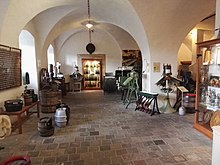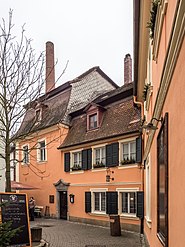Beer francs
Beer francs is a more recent counter-term to wine francs , which was initially only used as a joke. Although only both terms together describe the two great Franconian cultural landscapes , in contrast to the political three-way division with the Bavarian administrative districts of Lower Franconia , Middle Franconia and Upper Franconia . Beer Franconia includes the Upper Franconian, Middle Franconian and East Lower Franconian regions with a high density of breweries, in which a distinct beer culture is also cultivated. The core area of beer Franconia is in the areas in which the two dialects Bamberg and Upper Franconia are spoken.
classification
Beer francs and wine francs
Beer Franconia mainly refers to the Upper Franconian and Middle Franconian regions, in which, in contrast to the Lower Franconian areas around Würzburg , Kitzingen and Schweinfurt, more beer is brewed but no wine is grown. These are the regions around Bamberg , Bayreuth , Hof , Kulmbach , Nuremberg / Fürth / Erlangen and the Franconian Forest . The Franconian Switzerland with its over 100 microbreweries should be emphasized . The focus of beer Franconia is in the greater Bamberg area, with the highest density of breweries in the world until the 1960s. With 160 breweries worldwide, Bierfranken still has a very high brewery density and still has the highest density of historical breweries that brew conventional beer (see: Higher brewery density through craft beer ). The Haßberge district forms an overlap area between Weinfranken and Bierfranken , with wine towns on the Main and Steigerwald and (formerly) high breweries.
Western border of Beer Franconia
The western border of Bierfranken, which does not coincide with the eastern border of Weinfranken because of the overlapping area mentioned above, is identical to the Steigerwald barrier. This is the name of the western section of the Bamberg barrier near Augsfeld am Main, between Haßfurt and Zeil . Both terms describe the border between two subdialects Lower East Franconian in the west and Bamberg in the east. Due to the almost existing correspondence with the dialects, the East Franconian subdialects are shown fairly precisely on the map of wine francs (yellow surface colors) and beer francs (reddish surface colors), as well as the two different cultural landscapes , altitudes and climatic zones .
Higher brewery density through craft beer
In tourism advertising and among the Franconian population, people mistakenly speak of the highest density of breweries in the world even today. But if you only count the breweries that brew traditional beer, for which there are no statistical comparison values, this could possibly still apply. The purely numerical loss of the superlative has several reasons:
- Breweries and taverns are dying out in Germany, as the evening visit to taverns as a result of a changed lifestyle plays an ever smaller role;
- greater restriction of the consumption of alcohol by drivers, at work, for example in construction as well as a total rejection of alcohol in parts of the population for dogmatic or (supposedly) health reasons;
- Great counter-movement in the Anglo-Saxon world and elsewhere through craft beer , through which thousands of new, small breweries have been founded in recent times.
For some time now there has also been an increase in breweries in Germany as a result of the trend towards flavor-intensive craft beers. These are usually characterized by additives such as vanilla , rum chocolate , cinnamon and others, so they do not adhere to the German Purity Law and are often brewed in small breweries . These beers cannot be compared with the German or European brewing tradition, but they also revive traditional beer styles that fell victim to the industrial standardization of the pleasure market.
Upper Franconian cityscapes
Until the post-war decades, townscapes of Upper Franconian cities such as Bamberg, Kulmbach or Hof were shaped by breweries. The following picture gallery shows the u. a. using the example of the Unterkotzauer Weg in Hof. Since the 1980s, closed, mostly larger breweries were demolished for urban redevelopment. In recent times this has been prevented by the protection of monuments and attempts are being made to use the buildings for other purposes. Under the western old town of Bamberg, the mountain area , there is a labyrinth of beer cellars, which are indicated by street names such as Eisgrube .
- Breweries in Bamberg and Hof that shape the cityscape
See also
References and comments
- ↑ Beer Country Upper Franconia (. No longer available online) Archived from the original on February 3, 2014 ; Retrieved February 3, 2014 . Info: The archive link was inserted automatically and has not yet been checked. Please check the original and archive link according to the instructions and then remove this notice.
- ↑ Statistics on US Brewery Numbers. Retrieved February 10, 2018 .
- ↑ Augsburger Allgemeine: The number of breweries in Germany is increasing - Bavaria is ahead, March 27, 2017. Accessed February 10, 2018 .
- ↑ Deutschlandfunk Kultur: Purity Law was yesterday. Craft beer is booming - is the end of traditional beer? Retrieved February 10, 2018 .
- ↑ Archeology of Beer - Forgotten & Newly Discovered. In: Mixology - magazine for bar culture. September 8, 2016, accessed February 1, 2020 (German).







